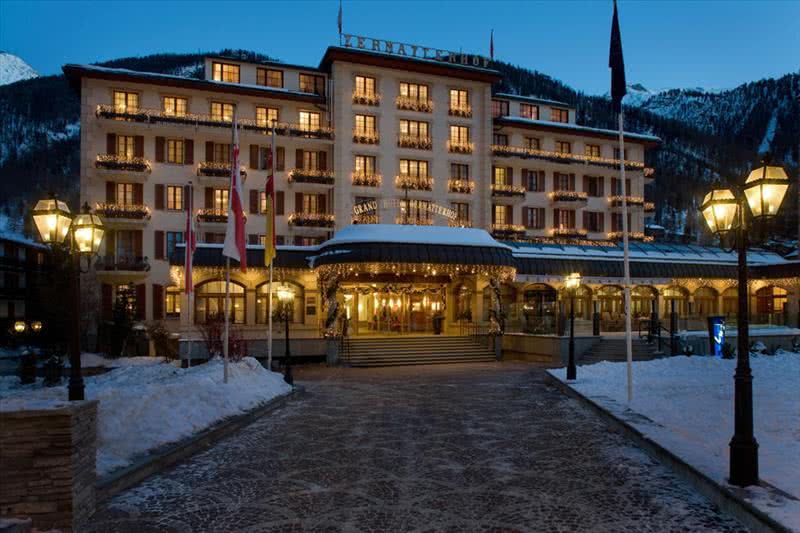The grand old hotels of the Alps
Grand luxury ski hotels in classic Alpine resorts from SNO
The oldest, most glamorous ski hotels – Grandes Dames of Alpine hospitality – have firmly secured their places in mountain history. Feats of spectacular architecture in spectacular surroundings, these historic hostelries have stood the test of time for a hundred years or more.
Often handed-down several generations of the same family, they offer a tried and true standard of high class luxury accommodation. Past and present blended to perfection, put these on your bucket list for a luxury ski trip back in time with all the mod-cons you could dream of.
with your own travel concierge. Don't hesitate to have our ski concierge provide
personally tailored options for your consideration
020 7770 6888 ← online or call ↴
020 7770 6888
Quite simply, winter holidays to the Alps may never have happened were it not for the Kulm…
It’s Johannes Badrutt we’re eternally grateful to - he took over St. Moritz’s first hotel, Pension Faller, and extended it with grand battlements and towers to shape the Kulm so known and loved today. Well-to-do Victorians spent their summers enjoying the mountain air and magnificent hospitality, and in the autumn of 1864 the idea of winter tourism was born: Badrutt was recalling the wonders of St Moritz winters to some of his British regulars, and bet them that if they came in December they’d love the climate, or he’d completely reimburse them. They took him up on the wager, had a fabulous time and returned home in the spring, tanned, rejuvenated and raving about a wonderful trip. Soon, wintering in St Moritz was the trendiest thing to do and guests of the Kulm began inventing their own winter sports for entertainment. The iconic Cresta run was built, the skeleton was invented and the openings of the second and fifth Olympic Games took place in the Kulm Park. Badrutt also installed Switzerland’s first ever electric lightbulb in the dining hall, where he hosted flamboyant masquerade balls.
Over 150 years on, the Kulm and St Moritz remain among the world’s most fashionable winter destinations: the hotel has more gourmet awards than you can shake a stick at, a spa to rival all other spas and feels so palatial you might mistake yourself for a monarch.
A setting more spectacular you’ll struggle to find: a peninsular pouring into a colossal alpine lake, with Salzburg peaks all around. It’s been this way since time immemorial, though the infrastructure changed enormously in the latter half of the nineteenth century: in 1864 you’d have found the Klampferhaus here, a humble home belonging to a tiny lakeside village. Come 1876, Josef Schwaiger transformed it into the Hotel Krone and by 1896 it was the imperial Grandhotel am See you’d recognise today, thanks to the hard work of the Böhm family.
The handsome hotel soon attracted the great and the good of Austria and beyond. But it wasn’t all halcyon days, with the two World Wars, floods, fires and a short stint as a university when the American troops took occupation. None managed to defeat it, and despite each setback the Grand was restored to its former glory standing elegant as ever. Its huge wellness centre, ornate dining rooms and Belle Époque bedrooms look out to the same glittering lake and snow-capped peaks that the old Klampferhaus did all those years ago.
Zermatt without glamorous hotels is tricky to picture, and it’s the Seiler brothers who set the ball rolling. There was only one inn here in 1853, a small six-bedroom wooden lodge. They bought it, christened it Monte Rosa and it became increasingly popular with climbers in the golden age of mountaineering. The hotel went down in history in 1865 when regular guest, Edward Whymper, returned to the Monte Rosa to spread the news having completed the first climb of the Matterhorn. You can still see his entry in the guest book today, thanking the Seilers for their “unwavering kindness” surrounding the fateful expedition.
Increasing in size and luxuries as the 20th century approached, the Monte Rosa became a glamorous gathering place for indulgent high teas, extravagant buffet suppers and opulent balls.
It’s has the same foundation walls from 1839, holds onto a boutiquey, Belle Époque feel and the Seilers are still in charge (now the fifth generation).
Like a castle in the Dolomites, the Adler Dolimiti harks all the way back to 1810 when Val Gardena local, Josef Sanoner, won an auction bid for the Daverda guesthouse. He named it Adler (meaning Eagle) and with the help of his horse (so the story goes!), found a wife. Over the next century, the hotel served as HQ for the German and Austrian Alpine Club and became a fashionable destination with over a hundred bedrooms, elegant dining rooms, a garden, library and billiards room. The bath house became the first wellness facility and by the twenties, top architects had sculpted the Adler into the grand, turreted hotel with its fine feature staircase still found today.
The sixth and seventh generations of Sanoners – brothers Andreas and Klaus and their families – now run the Adler. Their parents, Pepi and Elly, had installed the first spa in the Dolomites, and the hotel has now become a ‘spa and sport resort’, featuring the biggest pool and saunascape in the region, a health food restaurant and an extensive wellness programme. One in a long line of great Sanoner matriarchs, Elly’s still a strong presence in the Dolomiti – she has some wonderful tales of the Adler through the ages and her paintings can be found throughout.
Dating back to 1927 with the Jochum family having held the reins for three generations now, this fabulous hotel has a tale or two to tell… Princess Caroline of Monaco is one of the most distinguished returning patrons and many guests have been coming back for decades, like their parents and grandparents before them. They recall when the world’s first ski lift arrived in 1938 (and life before the lifts, which featured a lot more legwork!), the traditional New Year’s Day ‘Turtlerace’ (a fancy dress Lorünser remedy for a January 1st hangover…) and how since the fifties, cars have replaced horse drawn carriages. These days, the hotel’s little basement museum displays interesting photos and artefacts from through the ages.
Once a pension, the property has transformed into a 5* luxury hotel – an Arlberg classic with carved wooden ceilings, rustic stone and imperial Austrian furnishings. Keeping with the times, there’s a two-floor wellness centre and techno-gym.
It was the beginning of the twentieth century when newlyweds Romeo and Filomena Manaigo visited the Dolomites to fulfil their dream of running a hotel. Filomena found a fabulous spot with wraparound views of Dolomite peaks and fell firmly in love, declaring they’d build here and name their hotel Miramonti. By 1902, a castle-like building had appeared in the hills above Cortina, and it instantly became the biggest and most glamorous hotel for miles around. Monarchs and nobles from all over Europe stayed here, and the Miramonti’s classy appeal and striking surroundings soon caught the eye of Hollywood directors: the original Pink Panther featuring David Niven and Peter Sellars used it as a filming location, followed by Ash Wednesday starring Elizabeth Taylor and most famously, For Your Eyes Only where Roger Moore plays James Bond. Notable guests include Brigitte Bardot, Sophia Loren, Clark Gable and Elvis and the air of old-school Hollywood lux lives on indoors with marble-clad bathrooms, large, lavish hallways, a quaint piano bar and a vintage Italian dining room.
The venerable Maria Brunner is commander in chief at the Tiefenbrunner, which has been in her family since 1810. Portraits of her ancestors can be found throughout, and Maria and her children give fantastic accounts of how the hotel has been passed down the generations (spoiler alert – it includes a controversial relationship with a housekeeper, World War tragedies and magnificent matriarchs…). But two centuries seem a smidgen compared to the history of the building, which is a good 800 or so years old – the history books mention it as a guesthouse as early as the 13th century and prior to that it existed as a stable, a brewery and a hospital.
A prime example of age-old Tyrolean architecture, it’s in the heart of Kitzbühel’s historic quarter, painted bright orange and yellow with traditional shutters and the family’s 150-year-old coat of arms proudly emblazoned on the exterior. Indoors, a fabulous wellness area has a swimming pool, sauna, gym and relaxation zone.
Whizz back in time to December 1905: Gstaad is a pretty farming village and local teacher, Robert Steffen has just spotted a gap in the market for an incredible hotel. He buys a plot of land overlooking wooden chalets and gargantuan peaks, ropes in some investors and employs the very best architects he can find. Now hop forward a little to 1913: a turreted palace peers elegantly over its surroundings and the first winter guests are entering the Palace doors…
Back to the here and now: the Scherz family are in their third generation of running things, dab hands at delightful hospitality and mighty proud of their hotel’s history. They’ve welcomed Kings and Queens – of countries and pop – over the years (rumour has it Jacko once tried to buy it, and Madonna’s a regular). Rooms are revamped by a top interior designer twice a year and the spa is ceaselessly updating its offerings. There are five restaurants and the GreenGo nightclub holds onto the Seventies chic of its heyday - its New Year’s Eve bash (tickets upwards of CHF 1250) is easily the glitziest event in the Alps.
A second entry for Zermatt on this list, and a deserved one when you look at the resort’s incredible history and the hotel’s backstory... A brainwave of the local vicar, Josef Runden, the Zermatterhof was built by the ‘burghers of Zermatt’ (the oldest families in the parish) as a way of profiting from the area’s increasing influx of wealthy tourists. The burghers formed a cooperative and between 1876 and 1879, they built the biggest hotel in the area, labouring unpaid in return for shares in the hotel income.
Oozing grandeur on Zermatt’s iconic Bahnhofstrasse, the hotel is owned and run by the grandchildren and great grandchildren of the families that built it, and crests of the burgher names can be seen throughout. A time-honoured tradition sees horse-drawn carriages collect you from the station and displays of old guestbooks dating back to 1900 giving you a glimpse of those who’ve stayed before you.
In the late 1800’s, Jules Folliguet ran the little Villa Beauséjour, which hosted keen climbers including mountaineering legend Edward Whymper. With palatial hotels cropping up all over the Alps at the turn of the twentieth century, in 1914 he soon followed suit and built the ‘Grand Hotel Beau-Séjour and Richemond’.
Most of the old hotel buildings in Chamonix have been left abandoned or become museums. Though some are reopening to welcome guests (with the help of pricey refurbs), the Richemond has lived on unceasingly under the expert care of the Folliguet family. In the lively pedestrianised centre of Chamonix, it has the same elegant architecture and a lot of the furnishings are lovingly restored originals.
































































